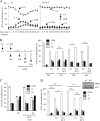Modulating estrogen receptor-related receptor-alpha activity inhibits cell proliferation
- PMID: 19546226
- PMCID: PMC2749102
- DOI: 10.1074/jbc.M109.028191
Modulating estrogen receptor-related receptor-alpha activity inhibits cell proliferation
Abstract
High expression of the estrogen receptor-related receptor (ERR)-alpha in human tumors is correlated to a poor prognosis, suggesting an involvement of the receptor in cell proliferation. In this study, we show that a synthetic compound (XCT790) that modulates the activity of ERRalpha reduces the proliferation of various cell lines and blocks the G(1)/S transition of the cell cycle in an ERRalpha-dependent manner. XCT790 induces, in a p53-independent manner, the expression of the cell cycle inhibitor p21(waf/cip)(1) at the protein, mRNA, and promoter level, leading to an accumulation of hypophosphorylated Rb. Finally, XCT790 reduces cell tumorigenicity in Nude mice.
Figures




References
-
- Foster J. S., Henley D. C., Ahamed S., Wimalasena J. (2001) Trends Endocrinol. Metab. 12,320–327 - PubMed
-
- Doisneau-Sixou S. F., Sergio C. M., Carroll J. S., Hui R., Musgrove E. A., Sutherland R. L. (2003) Endocr.-Relat. Cancer 10,179–186 - PubMed
-
- Massagué J. (2004) Nature 432,298–306 - PubMed
-
- Lin N. U., Winer E. P. (2008) J. Clin. Oncol. 26,798–805 - PubMed
Publication types
MeSH terms
Substances
LinkOut - more resources
Full Text Sources
Other Literature Sources
Research Materials
Miscellaneous

